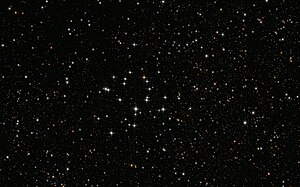Messier 39

|
|
| AladinLite | |
| Constellation | swan |
|
Position equinox : J2000.0 |
|
|---|---|
| Right ascension | 21 h 31.8 m |
| declination | + 48 ° 27 ′ |
| Appearance
|
|
| classification | III, 2, p (Trumpler), e (Shapley) |
| Brightness (visual) | 4.6 likes |
| Brightness (B-band) | 4.66 likes |
| Angular expansion | 32 ' |
| Number of stars | 30th |
| Brightest star | 6.83 likes |
| Physical data
|
|
| Redshift | −9 · 10 −6 |
| Radial velocity | −2.80 km / s |
| distance | 825 ly (253 pc ) |
| Absolute brightness | −2.5 mag |
| diameter | 7 years |
| Age | ≈ 250 million years |
| history | |
| Discovered by | Aristotle Charles Messier |
| Discovery time | 325 BC Chr. October 24, 1764 |
| Catalog names | |
| M 39 • NGC 7092 • C 2130 + 482 • OCl 211 • Mel 236 • Cr 438 • Lund 994 • | |
Messier 39 (also known as NGC 7092 ) is a +4.6 mag bright, 80-star open star cluster with an angular extension of 32 ' in the constellation Swan . It is located around 1000 light years away and its diameter is around nine light years.
It belongs to the middle age group (estimates are between 230 and 300 million years), which can be seen from the spectral types of the brightest cluster stars from A2 to B9. These stars have about twice the mass of the sun and are up to 80 times more luminous . As a result, they use their hydrogen much faster. With computer simulations, the age of the pile can be inferred.
observation

( Animation of the recording )
( recording without labeling )
M39 can be observed even with small telescopes or binoculars due to its considerable size of 32 arc minutes. Under good to very good conditions, it is even visible to the naked eye. In the telescope it appears approximately as a triangle with a bright star at each corner, the southern side of which is oriented from east to west.

